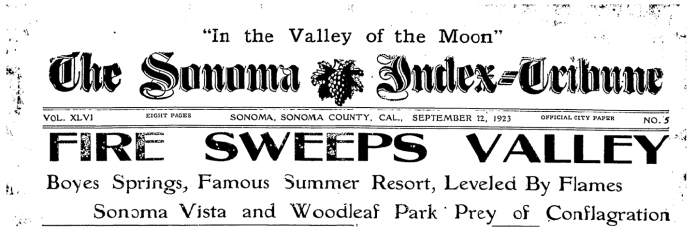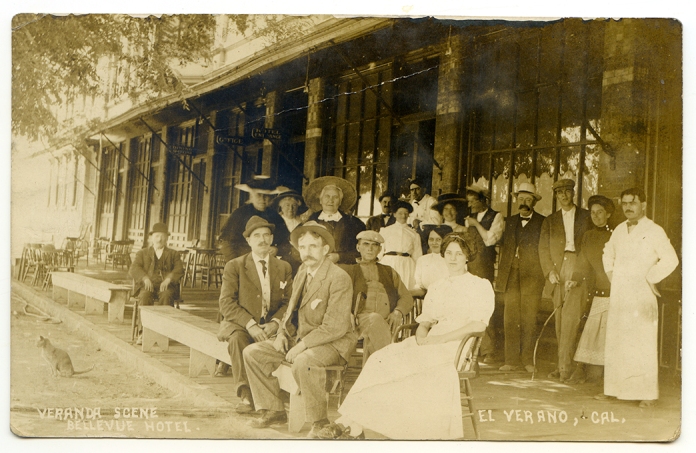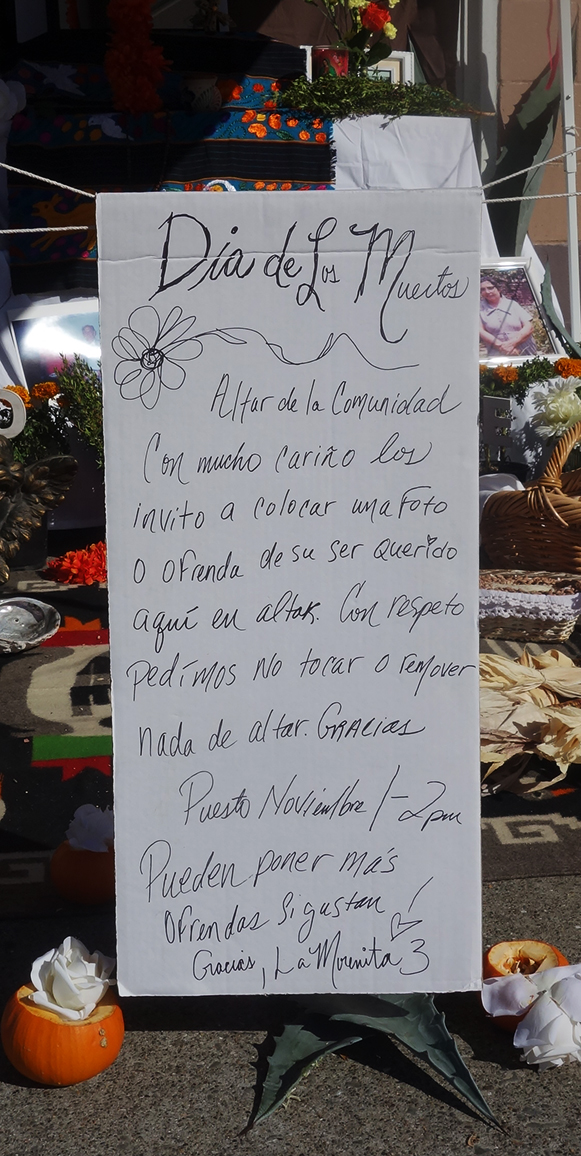Woodleaf Park is the name of one of the many subdivisions platted in the Springs around 1910. 
In August of 1921, the Index Tribune helpfully stated “The attention of our readers is called to the ad of the Woodleaf Grocery Store at Boyes Springs. This store in the Cabanot block is conducted by Mrs. Lovett and is giving excellent service to residents in and about the Springs.” (Notice a 1921 use of the term “the Springs.”) The Cabanot Block was at the corner of the State Highway and Boyes Blvd.
In September of 1923, most of Boyes Springs was destroyed by fire.
 But, by early 1924, rebuilding had begun. Mr. Cabanot hired builder M. Y. Hansen to construct the new Woodleaf Store, on the site of the old structure.
But, by early 1924, rebuilding had begun. Mr. Cabanot hired builder M. Y. Hansen to construct the new Woodleaf Store, on the site of the old structure.
In March of 1924, “It is reported (by the IT) that B. Cabanot, pioneer property owner and resort keeper of Boyes Springs, has sold out to E. Peters of San Francisco. Mr. Cabanot was one the first to show his faith in Boyes Springs real estate. He recently bought and improved a business block near the N. W. P. station which is now tenanted by store keepers.” It is assumed that this refers to Cabanot selling his resort, which was also near the railroad station.
Marion Greene was a community leader. In 1939 she was president of the Sonoma County Retail Grocer’s Association. She operated the Woodleaf Store from 1921 to 1949.

1930s. Lumber yard to the left. See Facebook comments below.

Year unknown, probably 1930s

1940s. Greyhound sign above windows at right. See Facebook comments.
Greene sold the store (not the building, which she did not own) to George Riccomi, a member of the Cabanot family, in 1951, and he installed a modern soda fountain and a horse-shoe counter in a “brilliant formica yellow design,” and chartreuse (!) leather upholstery, according the Index Tribune.

Chartreuse

Early 1950s. Alexamder Stark photo.


The Big Three Fountain, with its horse-shoe counter, in the 1980s
The interior was remodeled by architect Hugh Duffy and became the Big Three Market in 1959. The sign was modified to read “Big Three” at the top. Later, perhaps in the 1970s, the bottom portion was removed entirely. (Duffy was also the architect of the Plaza Center building and the Boyes Food Center.)

In 1980, the Sonoma Mission Inn Corporation, under Edward Safdie, bought the building and continued operation of the store and soda fountain. A later iteration of the Inn converted the store into a café. In 2016, the Fairmount Corporation closed the café permanently. Future plans for the site are unknown.
A recent posting on Facebook of a photograph of the Big Three elicited over 60 comments. Below are some samples.
I used to catch the Greyhound bus there in the mid 60s.
The Greyhound bus stopped there. You bought your ticket inside. Rose and I rode the Greyhound to San Francisco for a day. Met Burt and Walker. Our Mom’s didn’t know. Fun!
It was the Woodleaf and then the Big 3, my mother waitressed there when I was a kid. I would hang out readiing comics and wait for her to get off work, occasionally…great shakes, too!
Not many remember the lumber yard in the background. Diamond Lumber.
I remember those big swinging doors . … I think they got to be to dangerous. They blocked them off later and put the magazine rack in front of them.
I remember buying my first comic book there for $0.10. Around 1967.
And riding a pony ride they had out front.
I lived on Highland & Monterey area.
We had a ritual when I lived on 4th and Thompson, Frank’s trading post, swim at the Bath House, a quick Matinee at the Boyes Theatre, Big 3 for a new Comic and finally BHS Food Center during the warm months. Great time to live there.
I can still smell it and see the broken tiles in the sloped entrance
There were 3 owners- hence the name.
The fountain was where the men around met for coffee and to lie to each other in the morning.
I remember Polidori’s 5 & Dime across the street on the corner, maybe before the post office was there? I think he was the postmaster for awhile. Ate at Big 3 many times, mom shopped there often, we would buy $.05 donuts there, caught the bus there many times, and played in the abandoned lumber yard next door (across from Gallo’s) often
Toad stool was still there so had to be in the late 60’s or early 70’s
Toad stool.
We locals were known as “toads”
Creaky wood floors
Lyle Tuttle’s tattoo shop was next to the bus station. Sketchy area.
All images are from the author’s collection or courtesy of the Sonoma Valley Historical Society.











 But, by early 1924, rebuilding had begun. Mr. Cabanot hired builder M. Y. Hansen to construct the new Woodleaf Store, on the site of the old structure.
But, by early 1924, rebuilding had begun. Mr. Cabanot hired builder M. Y. Hansen to construct the new Woodleaf Store, on the site of the old structure.




















